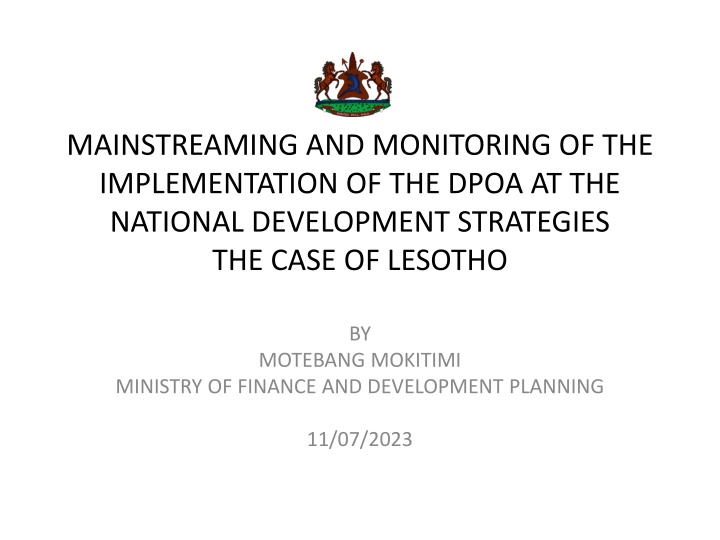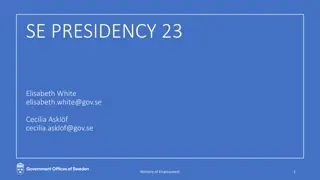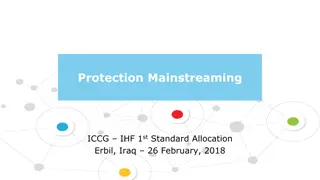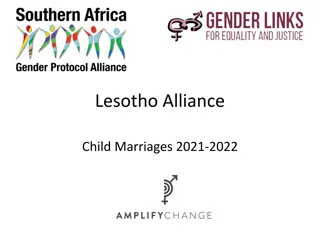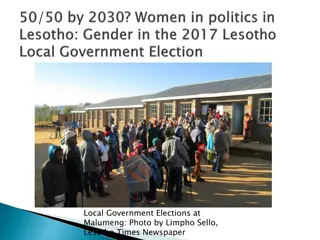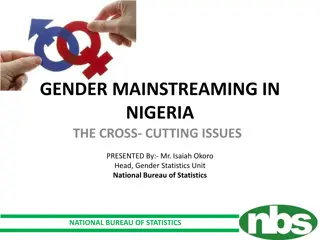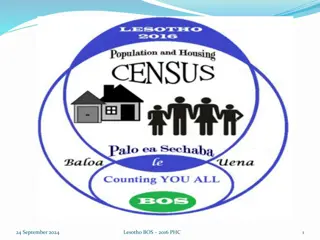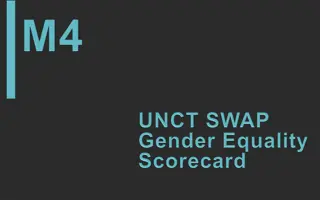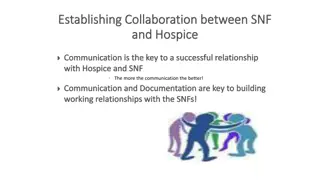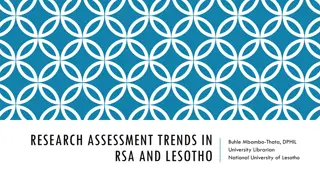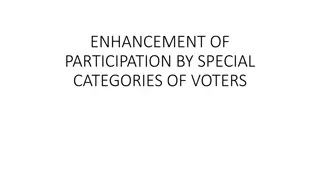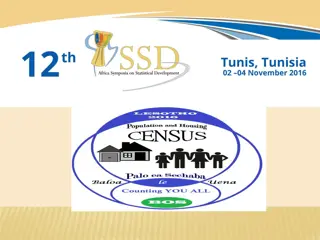Mainstreaming and Monitoring of the DPOA at the National Development Strategies: The Case of Lesotho
The Government of Lesotho is dedicated to implementing the Doha Programme of Action (DPoA) to support sustainable development. Mainstreaming and monitoring the DPoA at the national level are crucial for its success. Mainstreaming involves integrating the DPoA into existing plans and strategies, while monitoring ensures progress towards DPoA objectives. This article outlines the importance of alignment, integration, challenges, and strategies for effective implementation.
Download Presentation

Please find below an Image/Link to download the presentation.
The content on the website is provided AS IS for your information and personal use only. It may not be sold, licensed, or shared on other websites without obtaining consent from the author.If you encounter any issues during the download, it is possible that the publisher has removed the file from their server.
You are allowed to download the files provided on this website for personal or commercial use, subject to the condition that they are used lawfully. All files are the property of their respective owners.
The content on the website is provided AS IS for your information and personal use only. It may not be sold, licensed, or shared on other websites without obtaining consent from the author.
E N D
Presentation Transcript
MAINSTREAMING AND MONITORING OF THE IMPLEMENTATION OF THE DPOA AT THE NATIONAL DEVELOPMENT STRATEGIES THE CASE OF LESOTHO BY MOTEBANG MOKITIMI MINISTRY OF FINANCE AND DEVELOPMENT PLANNING 11/07/2023
OUTLINE 1. INTRODUCTION 2. MAINSTREAMING 3. MONITORING 4. ALIGNMENT AND INTERGRATION 5. ALIGNMENT AND INTEGRATION TOOLS 6. CHALLENGES 7. CONCLUSION
INTRODUCTION The Government of Lesotho (GoL) reaffirms its commitment in articulating and implementing the policies, plans and programmes that will support a sustainable future that leaves no one behind. The Doha Programme of Action (DPoA) for the Least Developed Countries (LDCs) for the Decade 2022-2023 is a ten-year plan adopted by the United Nations General Assembly in 2017. The DPoA aims to address the specific structural challenges faced by LDCs in achieving sustainable economic growth and development, thus enabling graduation from the least developed country category. To achieve the goals of the DPoA, it is crucial that the implementation of the plan is mainstreamed and monitored at the national level.
MAINSTREAMING Mainstreaming the DPoA refers to integrating the plan into national, subnational, and district plans, policies and strategies for development; and subsequently into budget allocations. This means that the DPoA is not viewed as a separate plan and cannot be achieved in isolation, but rather as part of a broader development agenda. The process involves identifying areas where the DPoA can be integrated into national policies and strategies. Also provides information on how United Nations Sustainable Development Cooperation Framework can be crafted to support implementation of those national plans. The Government of Lesotho (GoL) also establishes partnerships with stakeholders such as Development Partners, Civil Society Organizations (CSOs), Non-Governmental Organizations (NGOs), Academia and the Private Sector to raise awareness about the DPoA and promote its integration.
MONITORING Monitoring the implementation of the DPoA is equally important. It is crucial to have dedicated resources allocated towards implementation, monitoring, and reporting. This enhances tracking progress towards achieving the objectives of the program of action. The GoL uses a range of indicators to assess progress, including statistical data, surveys, and other empirical evidence. This information is then used to identify areas where progress is lacking and to develop strategies to address these gaps and harmonize reporting. I should highlight at this stage that integration is best done with focus on the indicator level of the DPoA provisions not at the Priority Area level. The country therefore localizes the DPoA and prioritizes the provisions, targets and indicators that have more functional linkages to national priorities and those with higher multiplier effect.
IMPLEMENTATION To ensure that mainstreaming and monitoring of the DPoA are effective, it is essential to have robust institutional frameworks and budget allocation in place. Here, the GoL establishes clear roles and responsibilities for different levels of government, as well as for stakeholder groups. Barring budgetary constraints, the GoL must invest in data collection, analysis and reporting and capacity building to ensure the technical knowledge and skills required for effective implementation. Finally, the GoL must also prioritize the allocation of resources towards programs and initiatives that support the implementation of the DPoA. Mainstreaming and monitoring of the DPoA at the national level are critical for achieving the objectives of the program of action and the overall realization of the global agenda for Sustainable Development Goals (SDGs). This requires an integrated and comprehensive approach with commitment from GoL to integrate the plan into their policies and strategies, as well as deliberate investment in monitoring and evaluation systems. It also necessitates collaboration with stakeholders to ensure that progress is tracked, and resources are allocated effectively to achieve the objectives of the DPoA.
IMPLEMENTATION It is also important to identify the policy mix that will help accelerate achievement of the DPoA and potential DPoA accelerators that the GoL could prioritize and embed into its national development frameworks. The Lesotho Partnership Policy and the UN Sustainable Development Cooperation Framework envisions stronger coordination between the country and the UN to ensure that the Doha Program of Action and the UN s 2030 Agenda are mainstreamed and integrated into the national planning frameworks.
PRIORITIZATION, ALIGNMENT AND INTEGRATION Define the scope of the Country Context Analysis (where are we now, development trends and national needs and realities, localize) Identify potential DPoA accelerators and aligning with country needs Identify what has worked and what has not (consider disruptive events, which data is available, past policy choices) What happened in specific sectors and across themes in the past (which development outcomes have been achieved) 1 Linking the DPoA priority areas and provisions with the NDP strategic areas, objectives (targets and indicators) Map out sources of quantitative and qualitative data to start the actual planning process considering the country context (Indicators based on the DPoA/SDGs, proxies) Mapping and review of relevant assessments and data sources 2 Integrated Context Analyses (integration across sectors and themes) Thematic analysis (e.g., Climate change, Gender, Peace and Justice, and Environment); Progress assessment and analysis Policy Integration (Synergies, Gaps and Trade-offs) Alignment and integration tools (evaluate the extent of alignment using tools such as IPRT) 3
ALIGNMENT AND INTEGRATION TOOLS The use the Rapid Integrated Assessment (RIA) or Integrated Planning & Reporting Toolkit (IPRT) tools to ensure alignment and integration with the SDGs, Agenda 2063 and international commitments has been useful. These tools allow integration of multiple development agendas into NDPs at goal, target and indicator levels and has enabled us to link programmes and projects to national, continental and global goals, target and indicators. Track progression and reporting towards achievement of continental and global development agendas (e.g., SDGs and A2063) in a harmonized way. The IPRT dashboard also helps track allocation and use of funds by programmes/projects.
CHALLENGES Capacity building: Should be done for all stakeholders and not only for government officials. Sensitization and advocacy: Should be done at the highest political level to ensure commitment and to ensure that sufficient resources are allocated towards successful implementation of the DPoA. Poor Dissemination: The DPoA should not only be communicated, but it must also be insured that it is understood. Lack of Participation of all stakeholders: this is critical in the successful implementation of the program. Limited Resources: the financial and technical constraints.
CONCLUSION The Government of Lesotho with support from the United Nations Country Team has undertaken painstaking activities to mainstream and align national, subnational, and district plans, policies, goals, objectives and strategies for development to the DPoA and other global and regional development agendas. Utilizing the decentralized planning system established; the Ministry of Finance and Development Planning (MoFDP), has also been able to ensure that the Ministerial Development Plans of Ministries, Departments and Agencies (MDAs) are properly aligned with the provisions of the DPoA, other global and regional development agendas. It is important to nurture and grow partnerships to streamline the DPoA. Partnerships between different actors could be facilitated and strengthened through the establishment and maintenance of functional formal platforms or networks through which the actors would interact, network and share experiences. Such platforms could be established at different levels (local councils, district administrations, national) for ease of access to actors operating at different levels.
